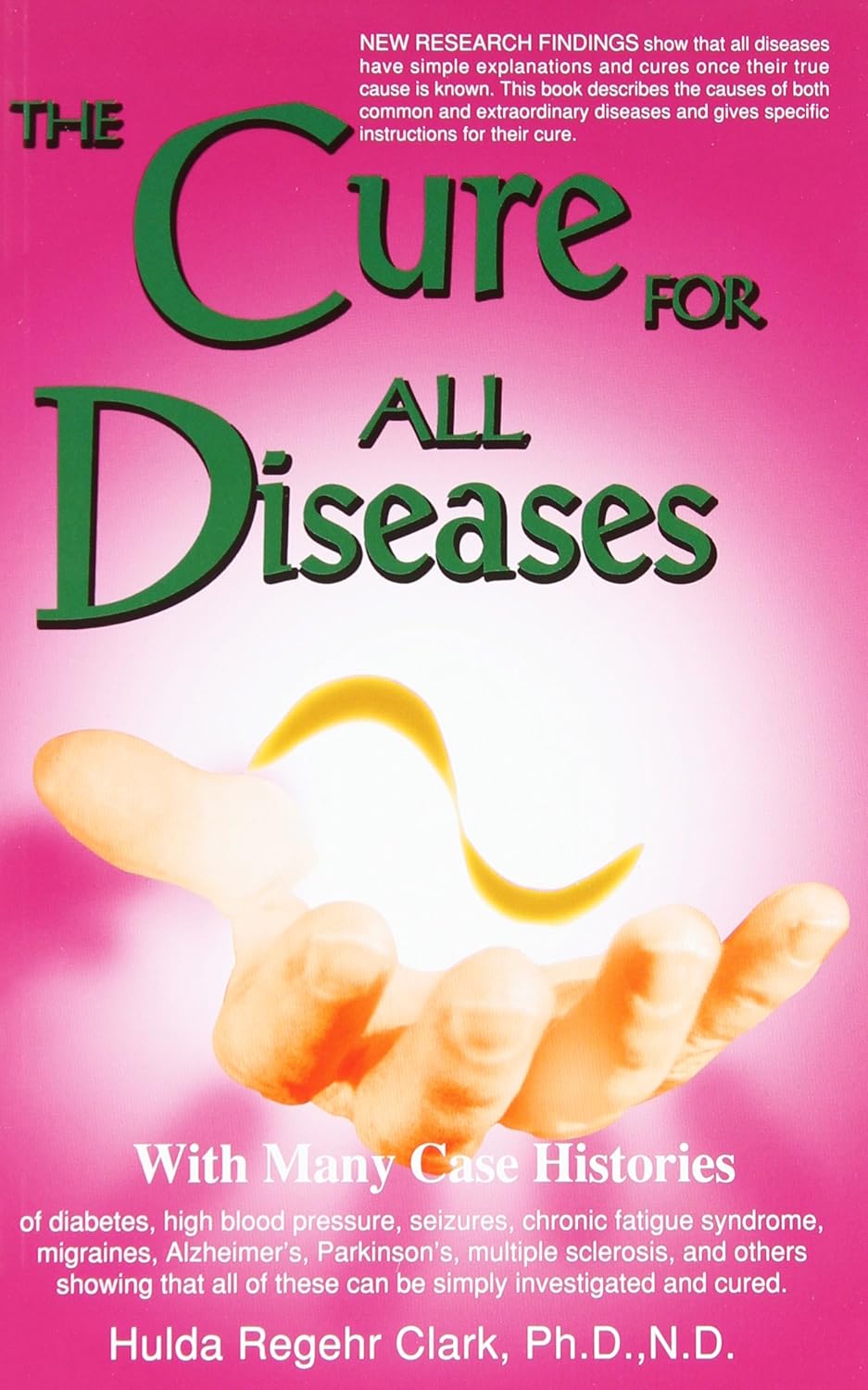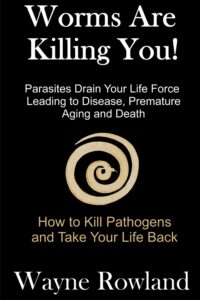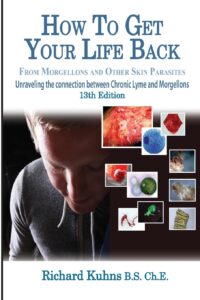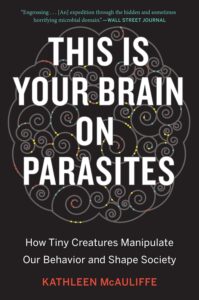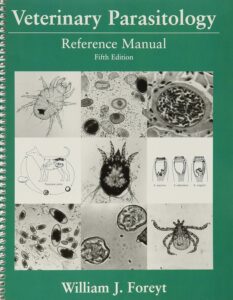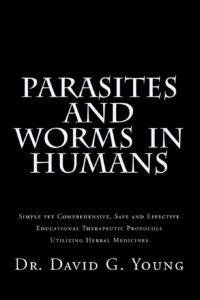Top 10 Books Linking Parasites and Worms with Human Diseases
The most troubling circumstance facing Americans today is the invisible link between parasites and diseases afflicting humans. These hidden invaders range from microscopic parasites to many-foot-long parasitic worms manipulating their hosts astonishingly, leading to severe health consequences. Though disregarded by modern medical science in the United States of America, understanding the relationship between parasites and diseases is critical for regaining optimal mental and physiological health today. The following are currently the top ten bestselling books demystifying the fascinating and sometimes terrifying world of parasites, how these organisms impact human health, and how to deal with them.
1. The Cure for All Diseases With Many Case Histories by Hulda Regehr Clark
“The Cure for All Diseases” by Hulda Regehr Clark is a controversial book that claims to offer simple explanations and cures for a wide range of diseases. Clark asserts that parasites and pollutants cause all diseases. She believes that by eliminating these factors, one can cure any disease. The book includes numerous case histories of individuals who cured themselves of various ailments, ranging from curing cancer to alleviating chronic pain. Clark claims that a combination of parasites and pollutants causes cancer and HIV/AIDS. She provides detailed instructions on how to use her Zapper and specific herbal treatments to cure cancer. Clark extends her theories to include common ailments from cold to chronic conditions like diabetes.
“The Cure for All Diseases” is a provocative book that challenges conventional medical wisdom. While some readers find hope and inspiration in Clark’s theories, others view it as a dangerous promotion of pseudoscience.
2. Worms Are Killing You! Parasites Drain Your Life Force Leading to Disease and Premature Death by Wayne Rowland
Rowland argues that parasites are a hidden cause of many chronic illnesses and premature deaths. The book educates readers on how these parasites invade the body, the health issues they cause, and how to kill them before they kill you via parasite cleanse and deworming. He explains how these organisms can enter the body through everyday activities and foods. The book provides detailed descriptions of the symptoms associated with parasitic infections, ranging from diabetes and digestive issues to mental health problems. Rowland advocates for natural treatments to eliminate parasites, highlighting historical deworming practices and modern natural remedies, including Silver Water Colloidal. One of the more controversial claims in the book is that modern medicine often overlooks parasites as a cause of illness. Rowland suggests that conventional treatments may sometimes perpetuate the problem rather than solve it, advocating for a more holistic approach to health.
“Worms Are Killing You!” is a provocative read that challenges readers to reconsider the role of parasites in their health. While some may find Rowland’s theories compelling and worth exploring, others may view them skeptically.
3. How to Get Your Life Back From Chronic Lyme, Morgellons, and Other Skin Parasites by Richard L. Kuhns
Kuhns provides an in-depth look at Morgellons, a controversial condition characterized by skin lesions and the sensation of crawling insects. He discusses various theories about its causes, including Lyme disease, fungal organisms, and other pathogens. Central to Kuhns’ approach is the “King Diet,” designed to starve parasites and parasitic worms while nourishing the body. The diet eliminates foods that feed parasites, such as certain oils, carbohydrates, fruits, and vegetables. The book outlines various natural remedies and supplements to help build immune function and combat parasites. Kuhns recommends specific products for deep cleaning the skin and boosting overall health. Testimonials include dramatic recoveries from chronic Lyme disease and Morgellons, highlighting the potential effectiveness of his approach. The book addresses the “Invisible Bug Biting Syndrome” phenomenon and offers strategies for identifying and treating infections caused by the parasitic worm Strongyloides stercoralis.
“How to Get Your Life Back From Chronic Lyme, Morgellons, and Other Skin Parasites” is a thorough and thought-provoking guide for those struggling with these challenging conditions. Kuhns’ holistic approach, combining diet, hygiene, and natural remedies, offers hope to many who feel abandoned by conventional medicine.
4. This Is Your Brain On Parasites How Tiny Creatures Manipulate Our Behavior and Shape Society by Kathleen McAuliffe
McAuliffe explains how parasites can alter the behavior of their hosts to ensure their survival and reproduction. This includes making rats less afraid of cats, causing fish to swim erratically, and influencing human behavior. The need to combat parasitic infections has influenced our immune systems, behaviors, and even societal structures. Aversion to dirt and disease may have evolved as a defense mechanism against parasites. The book describes the phenomenon of “zombie ants” and discusses how certain parasites might contribute to impulsivity, recklessness, and suicidal tendencies. The idea that parasites can shape entire societies is intriguing but remains a topic of ongoing scientific debate.
“This Is Your Brain On Parasites” is a thought-provoking and eye-opening book that challenges readers to reconsider the hidden influences on their behavior and society. McAuliffe’s engaging narrative and shocking examples make it a compelling read for anyone interested in the intersection of biology, psychology, and culture.
5. Veterinary Parasitology Reference Manual 5th Edition by William J. Foreyt
This manual is a thorough reference for diagnosing and treating parasitic infections in various animals, including domestic pets, livestock, wildlife, and even humans. Foreyt details the life cycles of various parasites, explaining their importance, location in the host, and zoonotic potential. This information is crucial for effectively understanding how to treat and prevent parasitic infections. One of the more alarming aspects covered in the book is the zoonotic potential of many parasites, meaning they can be transmitted from animals to humans. For example, the book discusses how parasites like Toxocara canis (dog roundworm) can cause serious human health issues, including visceral and ocular larva migrans. While the book is highly regarded for its thoroughness and practical utility, some critics argue that it may be too technical for those without a strong background in veterinary science.
“Veterinary Parasitology: Reference Manual, 5th Edition” is an invaluable resource for veterinary professionals. It provides detailed and practical information on diagnosing and treating parasitic infections in a wide range of animal species.
6. Guess What Came to Dinner? Parasites and Your Health by Ann Louise Gittleman PH.D. CNS
It is an informative book that delves into the hidden world of parasites and their impact on human health. Gittleman challenges the common misconception that parasitic infections are only a concern in developing countries. She proves parasites are a significant health issue in North America and other developed regions. Gittleman advocates for a holistic approach to preventing and treating parasitic infections. This includes dietary changes, natural remedies, and maintaining good hygiene practices. She also discusses the role of pets in transmitting parasites and offers tips on minimizing this risk. One of the most alarming sections of the book examines the impact of parasites on pregnant women and their babies. Gittleman explains how certain parasites can cause severe complications during pregnancy, including developmental issues and even miscarriage. Gittleman reveals that some parasites can live in the human body for decades, causing chronic health problems that are often misdiagnosed. She shares cases where individuals suffered for years before discovering that parasites were the root cause of their ailments.
“Guess What Came to Dinner? Parasites and Your Health” is an eye-opening and informative read that challenges readers to reconsider the hidden threats posed by parasites. Gittleman’s engaging writing and shocking examples make the book educational and compelling.
7. Medical Parasitology A Self-Instructional Text Seventh Edition by Ruth Leventhal PhD MBA MLS (ASCP), Russell F. Cheadle MS MLS
This textbook is designed for students and professionals in the medical and health sciences fields, providing a detailed yet accessible introduction to parasitology. It covers the major groups of parasites, including protozoa, helminths, and arthropods, and their impact on human health. The text includes comprehensive life cycle diagrams and epidemiological data for each parasite, helping readers understand how infections are transmitted and maintained in populations. The Book explains the complexity of some parasite life cycles. For example, the malaria parasite’s life cycle, Plasmodium spp., involves multiple stages in both human and mosquito hosts, highlighting the intricate strategies parasites use to survive and propagate. Medical Parasitology emphasizes the zoonotic potential of many parasites, meaning they can be transmitted from animals to humans. The text also covers emerging parasitic threats, such as Cryptosporidium and Giardia, which are increasingly recognized as significant causes of waterborne diseases. These parasites can cause severe gastrointestinal illness, particularly in immunocompromised individuals.
“Medical Parasitology: A Self-Instructional Text, Seventh Edition” is an invaluable resource for students and professionals in the medical and health sciences fields. Its detailed coverage of parasitic diseases, diagnostic techniques, and epidemiology makes it a must-have reference for anyone involved in parasitology.
8. Parasites and Worms in Humans: with Simple yet Comprehensive, Safe and Effective, Educational Therapeutic Protocols Utilizing Herbal Medicines by Dr. David G. Young N.D.
An educational reference designed to understand parasitic infections and their treatment using herbal medicines comprehensively. The book is structured to be easily understood by laypersons while providing detailed information for medical students. It includes references, genus classifications, disease types, and ICD-10 billing codes. The book contains practical instructions on obtaining and using the herbal medicines Dr. Young recommended. This makes it a hands-on guide for those looking to implement these treatments. Dr. Young highlights the alarming prevalence of zoonotic parasitic diseases, which are transmitted from pets to humans. He notes that many pediatricians see cases of such diseases annually, often involving roundworms, tapeworms, and hookworms. The book provides shocking examples of the severe health impacts that parasitic infections can have on humans. Dr. Young discusses how environments like backyards can become heavily contaminated with parasite eggs. For instance, he describes how house pets can shed millions of eggs, contaminating a large area and posing a long-term risk to both pets and humans.
“Parasites and Worms in Humans” is a thorough and practical guide for those interested in understanding and treating parasitic infections using herbal medicines. Dr. Young’s educational approach makes the book accessible to a broad audience, while his detailed protocols provide valuable guidance for those seeking alternative treatments.
9. Human Parasites: Diagnosis, Treatment, Prevention 2nd ed. by Heinz Mehlhorn
A comprehensive textbook that provides an up-to-date overview of the most important parasites affecting humans and their potential vectors. The book offers concise summaries for each parasite, covering eleven key sections: naming, geographic distribution and epidemiology, morphology, biology and life cycle, disease symptoms, diagnosis, infection pathways, prophylaxis, incubation period, prepatency, patency, and therapeutic options. It is richly illustrated with parasite life cycles, scanning electron microscopy (SEM) and transmission electron microscopy (TEM) micrographs, and over 200 colorful illustrations. These visuals help readers understand various parasites’ complex structures and life cycles. One of the more alarming aspects discussed in the book is how climate change and globalization increase the opportunities for parasites to thrive. This has led to the spread of parasites to new regions, posing significant public health challenges. Mehlhorn emphasizes the zoonotic potential of many parasites, meaning they can be transmitted from animals to humans. This includes parasites like Toxoplasma gondii, which can cause severe human health issues, including congenital infections and neurological disorders.
“Human Parasites: Diagnosis, Treatment, Prevention, 2nd Edition” is an invaluable resource for anyone involved in parasitology. Its detailed coverage of parasitic diseases, diagnostic techniques, and epidemiology makes it a must-have reference.
10. Parasitic Diseases 7th Edition by Dickson D Despommier, Daniel O Griffin
An authoritative textbook that delves into the complex world of parasitic diseases. The book covers many parasites, including protozoa, helminths, and ectoparasites. Each chapter provides detailed information on the biology, life cycle, epidemiology, clinical manifestations, diagnosis, treatment, and prevention of these parasites. The book includes additional life cycle diagrams that help readers visualize the complex life stages of various parasites. These diagrams are crucial for understanding how infections are transmitted and maintained. One of the most shocking examples discussed in the book is neurocysticercosis, caused by the pork tapeworm Taenia solium. This condition occurs when larvae invade the central nervous system, leading to severe neurological symptoms such as seizures, headaches, and even death. The book provides a detailed account of malaria caused by Plasmodium species. It highlights the devastating impact of this disease, which can cause severe anemia, cerebral malaria, and multi-organ failure. The life cycle of the parasite, involving both human and mosquito hosts, is intricately detailed. Another alarming example is leishmaniasis, caused by Leishmania parasites. The book describes how this disease can lead to disfiguring skin ulcers and, in its visceral form, can be fatal if untreated. It thoroughly explains the complex life cycle involving sandfly vectors.
“Parasitic Diseases, 7th Edition” is an invaluable resource for anyone involved in the field of parasitology. Its detailed coverage of parasitic diseases, diagnostic techniques, and epidemiology makes it a must-have reference. Including clinical summaries, life cycle diagrams, and a pronouncer’s guide enhances its practicality and usability.
Many books focus on the connections between parasites, parasitic worms, their waste, and disease. Please share your favorites below:
